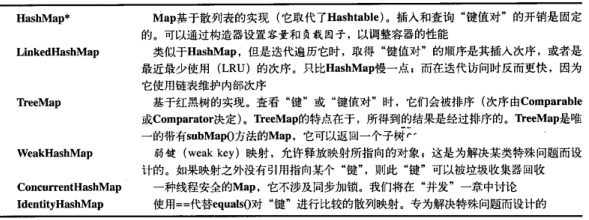《Think in Java》17~18
chapter 17 容器深入研究
填充容器
package cn.test; import java.util.ArrayList;
import java.util.Collections;
import java.util.List; class StringAddress{
private String s;
public StringAddress(String s) {this.s=s;};
public String toString() {
return super.toString()+" "+s;
} }
public class FillingLists {
public static void main(String[] args) {
List<StringAddress> list=new ArrayList<StringAddress>(Collections.nCopies(4, new StringAddress("Hello")));
System.out.println(list);
Collections.fill(list, new StringAddress("World!"));
System.out.println(list);
}
}
一种Generator解决方案
public interface Generator<T> {
T next();
}
package cn.test;
import java.util.ArrayList;
public class CollectionData<T> extends ArrayList<T> {
public CollectionData(Generator<T> gen,int quantity) {
for(int i=0;i<quantity;i++) {
add(gen.next());
}
}
public static <T> CollectionData<T>
list(Generator<T> gen,int quantity){
return new CollectionData<T>(gen,quantity);
}
}
Set和存储顺序

队列
package cn.test; import java.util.LinkedList;
import java.util.PriorityQueue;
import java.util.Queue;
import java.util.concurrent.ArrayBlockingQueue;
import java.util.concurrent.ConcurrentLinkedQueue;
import java.util.concurrent.LinkedBlockingQueue;
import java.util.concurrent.PriorityBlockingQueue; public class QueueBehavior {
private static int count=10;
static <T> void test(Queue<T> queue,Generator<T> gen) {
for(int i=0;i<count;i++) {
queue.offer(gen.next());
while(queue.peek()!=null) {
System.out.print(queue.remove()+" ");
}
}
System.out.println();
}
static class Gen implements Generator<String>{
String[] s=("one two three four five six seven "
+ "eight nine ten").split(" ");
int i;
public String next() {
return s[i++];
} }
public static void main(String[] args) {
test(new LinkedList<String>(),new Gen());
test(new PriorityQueue<String>(),new Gen());
test(new ArrayBlockingQueue<String>(count),new Gen());
test(new ConcurrentLinkedQueue<String>(),new Gen());
test(new LinkedBlockingQueue<String>(),new Gen());
test(new PriorityBlockingQueue<String>(),new Gen()); } }
优先级队列
理解Map
性能


SortedMap
散列与散列码
package cn.test; import java.lang.reflect.Constructor;
import java.util.HashMap;
import java.util.Map;
import java.util.Random; class Groundhog{
protected int number;
public Groundhog(int n) {number = n;}
public String toString() {
return "Groundhog # "+number;
}
}
class Prediction{
private static Random rand=new Random(47);
private boolean shadow=rand.nextDouble() > 0.5;
public String toString() {
if(shadow)
return "Six more weeks of Winter!";
else
return "Early Spring!";
}
}
public class SpringDetector {
public static <T extends Groundhog>
void detectSpring(Class<T> type)throws Exception{
Constructor<T> ghog = type.getConstructor(int.class);
Map<Groundhog,Prediction> map=new HashMap<Groundhog,Prediction>();
for(int i=0;i<10;i++)
map.put(ghog.newInstance(i), new Prediction());
System.out.println("map = "+map);
Groundhog gh = ghog.newInstance(3);
System.out.println("Looking up prediction for "+gh);
if(map.containsKey(gh))
System.out.println(map.get(gh));
else
System.out.println("Key not found: "+gh);
}
public static void main(String[] args) throws Exception {
detectSpring(Groundhog.class);
}
}
为速度而散列
覆盖hashCode()
Collection或Map的同步控制
public class Synchronization {
public static void main(String[] args) {
Collection<String> c = Collections.synchronizedCollection(new ArrayList<String>());
List<String> list = Collections.synchronizedList(new ArrayList<String>());
Set<String> s = Collections.synchronizedSet(new HashSet<String>());
SortedSet<String> ss = Collections.synchronizedSortedSet(new TreeSet<String>());
Map<String,String> m=Collections.synchronizedMap(new HashMap<String,String>());
Map<String,String> sm=Collections.synchronizedSortedMap(new TreeMap<String,String>());
}
}
快速报错
public class FailFast {
public static void main(String[] args) {
Collection<String> c=new ArrayList<String>();
Iterator<String> it=c.iterator();
c.add("An object");
try {
String s=it.next();
} catch (ConcurrentModificationException e) {
System.out.println(e);
}
}
}
// java.util.ConcurrentModificationException
在获取迭代器后,容器发生了变化。
持有引用
Hashtable
Hashtable 过时的类,线程安全,键值不为null;
HashMap 线程不安全 ,但可以通过Collections类转为线程安全。Map m = Collections.synchronizeMap(hashMap),键值可以为null;
Stack
package cn.test; import java.util.LinkedList;
import java.util.Stack; enum Month{
january,february,march,april,may,june,july,august,september,october,november
}
public class Stacks {
public static void main(String[] args) {
Stack<String> stack=new Stack<String>();
for(Month m:Month.values())
stack.push(m.toString());
System.out.println("stack = "+ stack);
stack.addElement("The last line");
System.out.println("element 5 = "+stack.elementAt(5));
System.out.println("popping elements : ");
while(!stack.empty())
System.out.println(stack.pop()+" ");
LinkedList<String> lstack=new LinkedList<String>();
for(Month m: Month.values())
lstack.addFirst(m.toString());
System.out.println("lstack = "+lstack);
while(!lstack.isEmpty())
System.out.println(lstack.removeFirst()+" ");
}
}
chapter 18 Java I/O系统
输入和输出
XML
I/O流的典型使用方式
对象序列化
对于某些实现了Serialiazable 又不想被序列化的字段,可以在字段前添加 transient 关键字。
《Think in Java》17~18的更多相关文章
- 读书笔记 之《Thinking in Java》(对象、集合)
一.前言: 本来想看完书再整理下自己的笔记的,可是书才看了一半发现笔记有点多,有点乱,就先整理一份吧,顺便复习下前面的知识,之后的再补上. 真的感觉,看书是个好习惯啊,难怪人家说"书籍是人类 ...
- 《Head First Java》读书笔记(1) - Java语言基础
<Head First Java>(点击查看详情) 1.写在前面的话 这本书的知识点说实话感觉有点散乱,但是贵在其将文字转换成了生动和更容易接受的图片,大量的比喻让人感受到了知识点的有趣之 ...
- 读书笔记 之《Thinking in Java》(对象、集合、异常)
一.前言 本来想看完书再整理下自己的笔记的,可是书才看了一半发现笔记有点多,有点乱,就先整理一份吧,顺便复习下前面的知识,之后的再补上. 真的感觉,看书是个好习惯啊,难怪人家说“书籍是人类进步的阶梯” ...
- 《Play for Java》学习笔记(一)项目框架
从今天开始认真复习<Play for JAVA>,该书以一个案例为主线,以前为应付项目马马虎虎看了一遍,好多地方都不明白!现在跟着这本书再走一遍,认真模拟,当做一个项目啦!! 一.Play ...
- 《图书管理系统——java》
/* (程序头部凝视開始) * 程序的版权和版本号声明部分 * Copyright (c) 2011, 烟台大学计算机学院学生 * All rights reserved. * 文件名: < ...
- 【书海】《Head First Java》 ——读后总结
<Head First Java> 中文版 (第二版) IT`huhui前言录 <Head First Java>这本书我不算特别细的看了一遍.认为十分适合初学者,甚至是没接触 ...
- 我本人一直以来犯的错误,在看了《Think In Java》后才抓了出来(转)
也许你是只老鸟,也许你的程序编的很精,但是,在你的程序生活,你也许没有注意到一些“常识性”的问题,因为有些时候我们不需要去注意,我们的程序 照样能够运行得飞快,但是如果那天有一个无聊的人问你一个像这样 ...
- 《Thinking in Java》 And 《Effective Java》啃起来
前言 今天从京东入手了两本书,<Thinking in Java>(第四版) 和 <Effective Java>(第二版).都可以称得上是硬书,需要慢慢啃的,预定计划是在今年 ...
- D1——初读《Head First Java》
今天随便看了点<Head First Java>,发觉这本书的风格真是有趣.打算先把这本书踏踏实实的看了.学习切忌好高骛远.心浮气躁,尤其入门基础阶段更应该踏踏实实地学习知识.下面随便谈谈 ...
随机推荐
- Ubuntu 安装 kamailio
首先安装前,你已经对kamailio的基本用法了解.可根据情况选择安装方式,本次安装基于Ubuntu18.04系统安装,对于16.04及一下会遇到版本问题,请自己查阅文档解决 安装第三方库 sudo ...
- What is _MainTex_ST ?
[What is _MainTex_ST ?] 在Unity自带的Unlit/Texture中,有引用到float4 _MainTex_ST,如下: // Unlit shader. Simplest ...
- 自然语言处理之中文分词器-jieba分词器详解及python实战
(转https://blog.csdn.net/gzmfxy/article/details/78994396) 中文分词是中文文本处理的一个基础步骤,也是中文人机自然语言交互的基础模块,在进行中文自 ...
- sqlserver 文件与文件组的使用和优化
文件和文件组填充策略 文件组对组内的所有文件都使用按比例填充策略.当数据写入文件组时,SQL Server 数据库引擎按文件中的可用空间比例将数据写入文件组中的每个文件,而不是将所有数据都写入 ...
- jvisualvm远程监控服务器tomcat
1.在 {服务器tomcat路径}/bin/catalina.sh 中,的[# OS specific support. $var _must_ be set to either true or f ...
- c# dynamic的属性是个变量
using System; using System.Collections.Generic; using System.Linq; using System.Text; using System.T ...
- 浅谈css float
相信许多许多Web前端的朋友一定被float这个属性给困扰过吧,有时候用它来布局很方便,能够实现元素快速的水平排列,但有时候它又像一个精灵,让人无法琢磨透它方位.在网上也看了一些关于float的帖子, ...
- Perl 学习笔记-正则表达式应用篇
1.以 m// 进行匹配 如: m/roger/ , /roger/ 是它的简写; 在说明 qw// 时可以选择使用任何成对的定界符, 对应m//匹配也可以, 如写成: m(roger) ...
- [GO]匿名函数和defer
package main import "fmt" func main() { a := 10 b := 20 defer func() { fmt.Printf("a ...
- Html创建表单
echo Html::beginForm(['/site/logout'], 'post'); echo Html::submitButton(Yii::t('app', 'logout'), ['c ...
